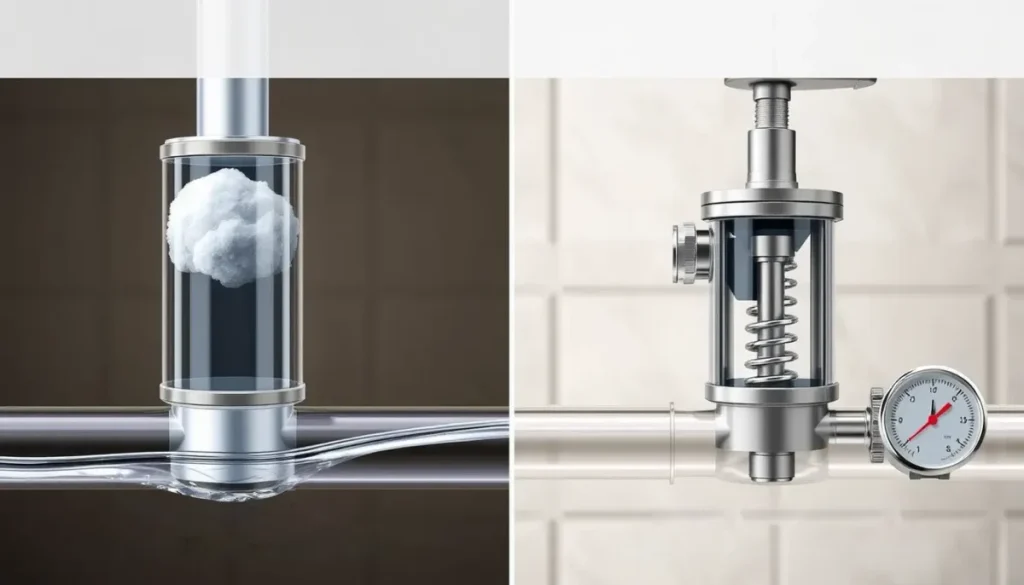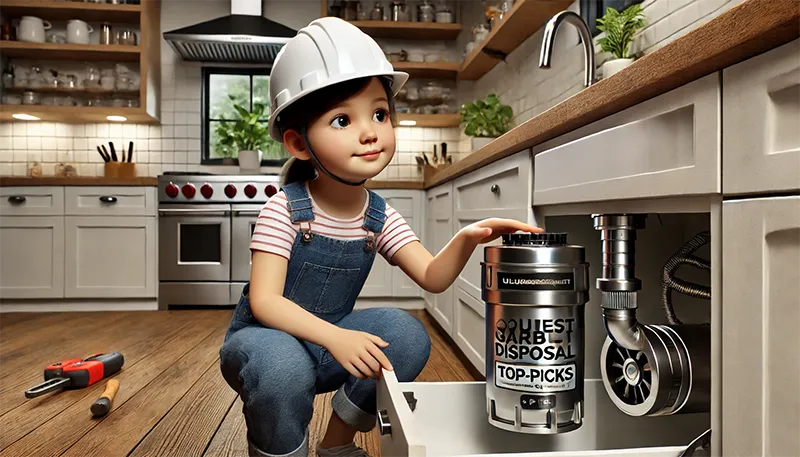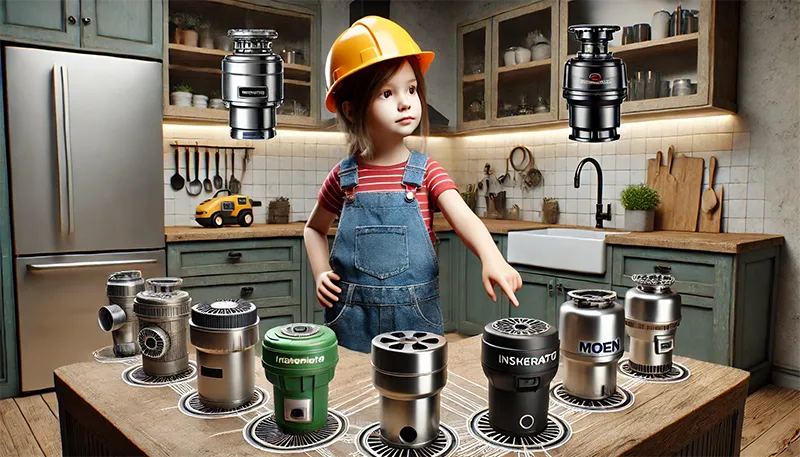Water hammer is a common and potentially damaging phenomenon in residential plumbing systems. It occurs when the flow of water in pipes is suddenly stopped or changed, creating a shockwave that reverberates through the plumbing system. This sudden change in pressure can cause a loud banging noise, hence the term “water hammer.” While the noise itself is annoying, the real concern lies in the potential damage to pipes, fittings, and appliances over time.
What Causes Water Hammer?
- Quick-closing valves: When faucets or appliances with solenoid valves (like washing machines or dishwashers) shut off quickly, they can cause water hammer.
- High water pressure: Excessive pressure in the plumbing system can exacerbate water hammer effects.
- Loose pipes: Pipes that aren’t properly secured can move and bang against walls or other structures when water flow changes, contributing to water hammer.
- Air in pipes: Air pockets in the plumbing system can compress and expand, amplifying water hammer effects.
To mitigate water hammer, plumbing systems often incorporate devices designed to absorb these pressure shocks. The two primary solutions for water hammer are air chambers and mechanical arrestors.
Factors to Consider When Choosing Between Air Chambers and Mechanical Arrestors for Water Hammer
When retrofitting a residential plumbing system, several factors should be considered to determine the most appropriate water hammer solution:
Plumbing System Layout
Air chambers may be more suitable for systems with ample vertical space near fixtures. Mechanical arrestors are advantageous in tight spaces or where horizontal installation is necessary for water hammer solutions.
Accessibility
If the installation area is easily accessible for future maintenance, air chambers might be a viable option for water hammer solutions. For hard-to-reach areas, mechanical arrestors are preferable due to their maintenance-free nature in water hammer solutions.
Water Quality
In areas with hard water, mechanical arrestors may be more resistant to mineral buildup and scaling compared to air chambers in water hammer solutions.
Budget Considerations
While air chambers have a lower initial cost, factor in potential future maintenance expenses for water hammer solutions. Mechanical arrestors have a higher upfront cost but require minimal ongoing maintenance for water hammer solutions.
Local Building Codes
Some jurisdictions have specific requirements or preferences for water hammer solutions. Check local plumbing codes to ensure compliance for water hammer solutions.
DIY vs. Professional Installation
Air chambers are generally easier for DIY installation in water hammer solutions. Mechanical arrestors may require professional installation, especially for precise sizing and placement in water hammer solutions.
Long-term Reliability for Water Hammer Solutions
If long-term, maintenance-free operation is a priority, mechanical arrestors are the better choice for water hammer solutions.
System Pressure for Water Hammer Solutions
For high-pressure systems, mechanical arrestors may offer better protection against water hammer due to their consistent performance in water hammer solutions.
Installation Best Practices for Water Hammer Solutions
Regardless of the chosen solution, proper installation is crucial for effective water hammer mitigation. Here are some best practices to follow for water hammer solutions:
For Air Chambers
- Install air chambers as close to the source of water hammer as possible for effective water hammer solutions.
- Ensure the chamber is at least 12 inches long and has a diameter equal to or larger than the supply pipe for water hammer solutions.
- Use vertical installation to maintain the air pocket for water hammer solutions.
- Consider installing multiple air chambers for fixtures with both hot and cold water supplies for water hammer solutions.
- Provide access panels if air chambers are installed behind walls for future maintenance in water hammer solutions.
For Mechanical Arrestors
- Choose the correct size based on fixture unit ratings and manufacturer recommendations for water hammer solutions.
- Install arrestors as close to the source of water hammer as possible, typically within 6 feet for water hammer solutions.
- For washing machines and dishwashers, use arrestors specifically designed for appliance connections in water hammer solutions.
- In multi-story buildings, consider installing arrestors on each floor to address pressure variations in water hammer solutions.
- Follow manufacturer instructions for orientation (vertical, horizontal, or angled installation) in water hammer solutions.
- Use appropriate fittings and ensure a secure, leak-free connection for water hammer solutions.
Maintenance Considerations
Air Chambers
- Frequency: Check and maintain air chambers annually or when water hammer becomes noticeable for water hammer solutions.
- Process:
- Shut off the main water supply for water hammer solutions
- Open the highest faucet in the house for water hammer solutions
- Open the lowest faucet to drain the system for water hammer solutions
- Close the lowest faucet and turn the water supply back on for water hammer solutions
- Close the highest faucet when water flows smoothly for water hammer solutions
Mechanical Arrestors
- Inspection: Periodically check for leaks or signs of damage in water hammer solutions.
- Replacement: If water hammer returns or leaks occur, the arrestor may need replacement for continued water hammer solutions.
- No routine maintenance required: Under normal conditions, mechanical arrestors do not need regular servicing for water hammer solutions.
Special Considerations for Residential Retrofitting in Water Hammer Solutions
Retrofitting an existing plumbing system presents unique challenges compared to new construction in water hammer solutions. Consider the following when choosing and installing water hammer solutions:
- Access: Evaluate the accessibility of installation points for water hammer solutions. Mechanical arrestors may be preferable in tight spaces for water hammer solutions.
- Existing plumbing condition: Assess the overall condition of the plumbing system for water hammer solutions. Older pipes may require additional support or replacement alongside water hammer mitigation in water hammer solutions.
- Integration with existing fixtures: Ensure the chosen solution can be effectively integrated with existing fixtures and appliances for water hammer solutions.
- Minimal disruption: Choose solutions and installation methods that minimize disruption to walls, floors, and ceilings for water hammer solutions.
- Future maintenance: Consider long-term access for maintenance, especially if choosing air chambers for water hammer solutions.
- System pressure: Evaluate the overall system pressure for water hammer solutions. High-pressure systems may benefit more from mechanical arrestors for water hammer solutions.
- Cost-effectiveness: Balance the cost of installation with long-term benefits and potential savings from prevented damage in water hammer solutions.
FAQs
-
Can I install water hammer arrestors myself?
While it’s possible for experienced DIYers to install air chambers or some mechanical arrestors, professional installation is recommended for optimal performance and to ensure compliance with local codes in water hammer solutions.
-
How long do mechanical arrestors typically last in water hammer solutions?
Quality mechanical arrestors can last 10-20 years or more under normal conditions in water hammer solutions. However, lifespan can vary based on water quality, pressure, and usage patterns in water hammer solutions.
-
Will water hammer arrestors eliminate all plumbing noises in water hammer solutions?
While arrestors can significantly reduce water hammer, they may not eliminate all plumbing noises in water hammer solutions. Other issues like loose pipes or high water pressure may need to be addressed separately in water hammer solutions.
-
Can air chambers and mechanical arrestors be used together in the same system for water hammer solutions?
Yes, they can be used together, especially in larger systems or those with diverse fixtures in water hammer solutions. However, it’s generally more efficient to choose one solution and apply it consistently in water hammer solutions.
-
Are there any alternatives to air chambers and mechanical arrestors for water hammer solutions?
Other solutions include pressure-reducing valves, flexible connectors, and pipe insulation for water hammer solutions. However, these are often complementary rather than direct alternatives to air chambers or arrestors in water hammer solutions.
Conclusion
Choosing between air chambers and mechanical arrestors for water hammer mitigation in a residential retrofitting project depends on various factors, including the specific plumbing setup, budget constraints, and long-term maintenance considerations for water hammer solutions. While air chambers offer a simple and cost-effective solution, they require periodic maintenance and may become less effective over time in water hammer solutions. Mechanical arrestors, on the other hand, provide consistent, long-term performance without the need for regular maintenance, albeit at a higher initial cost in water hammer solutions.
For most residential retrofitting projects, mechanical arrestors offer the best long-term solution due to their reliability, consistent performance, and low maintenance requirements in water hammer solutions. However, air chambers can still be effective in certain situations, especially when budget is a primary concern or in areas where regular maintenance is not an issue in water hammer solutions.
Remember, proper installation is crucial for either solution to work effectively in water hammer solutions. If you’re unsure about which option is best for your home, consult a licensed plumber who can assess your specific needs and recommend the most suitable solution for water hammer solutions.
By addressing water hammer issues, you not only create a more comfortable living environment but also protect your plumbing system from potential damage, potentially saving significant repair costs in the long run in water hammer solutions.
We encourage you to share your experiences with water hammer solutions. Let’s work together to create quieter, more efficient plumbing systems in our homes with effective water hammer solutions!



